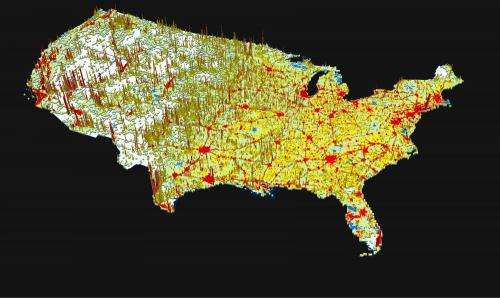New model explores location of future US population growth

Researchers at the Department of Energy's Oak Ridge National Laboratory have developed a population distribution model that provides unprecedented county-level predictions of where people will live in the U.S. in the coming decades.
Initially developed to assist in the siting of new energy infrastructure, the team's model has a broad range of implications from urban planning to climate change adaptation. The study is published in the journal Proceedings of the National Academy of Sciences.
"We do a census every 10 years because those data help us do long-term socioeconomic planning," said Budhendra Bhaduri, who leads ORNL's Geographic Information Science and Technology group. "Population projection numbers are important, but many pressing societal needs also require an understanding of where people are going to be. This has always been a challenge; we've never had a good method to make future projections spatially explicit."
The new model builds on years of research in the development of two other ORNL technologies that supply geographical distribution of population: LandScan Global provides one-kilometer resolution for the world and LandScan USA provides 90-meter resolution for the U.S. Incorporating regional variables such as land cover, slope, distances to larger cities, roads and population movement allowed the researchers to refine future population distributions by county.
"We took the U.S. national population total and downscaled to the county level to examine how local population growths vary geographically," said ORNL's Jacob McKee, the study's lead author.
In the study's projections for 2030 and 2050, the researchers set constraints for each contiguous U.S. county under a business-as-usual scenario based on historical conditions. The team's analysis of this scenario found that sprawl growth was projected to be most prevalent in the following counties: El Dorado, CA, Maricopa, AZ, and Riverside, CA.
The researchers note that the current study presents one of many potential outcomes, and the model can be adjusted to consider additional variables and scenarios. For instance, extreme weather events or local investments such as new industries can drastically affect where people move, but these factors are impossible to predict decades in advance.
"Our research is a demonstration of a model that can be tailored to specific scenarios to measure population in different ways," McKee said. "This is by no means a definitive answer of what's going to happen."
The researchers hope their model will aid in long-term planning efforts in a wide variety of fields.
"Changes in climate-induced disaster patterns, epidemiological events and infrastructure planning underscore the need to quantify and map the current population," Bhaduri said. "Predicting the distribution of future populations allows for improved adaptation and mitigation strategies."
More information: Locally adaptive, spatially explicit projection of US population for 2030 and 2050, Jacob J. McKee, PNAS, DOI: 10.1073/pnas.1405713112
Journal information: Proceedings of the National Academy of Sciences
Provided by Oak Ridge National Laboratory


















